Stock Markets Extreme Volatility
Stock-Markets / US Stock Markets Sep 20, 2008 - 08:06 PM GMTBy: Mike_Burk
Short Term Over the past week the Dow Jones Industrial Average (DJIA) moved and average of 2.4% a day, the highest level of volatility since the low of October 2002.
The chart below covers the past 6 months showing the DJIA in red and an indicator showing the average daily percentage change of the DJIA over the previous 5 trading days in black. The indicator is calculated by adding the absolute value of the percentage change of the DJIA over the previous 5 trading days and dividing by 5. Dashed vertical lines have been drawn on the 1st trading day of each month.
At 2.4% the indicator is at its highest level since 2002.
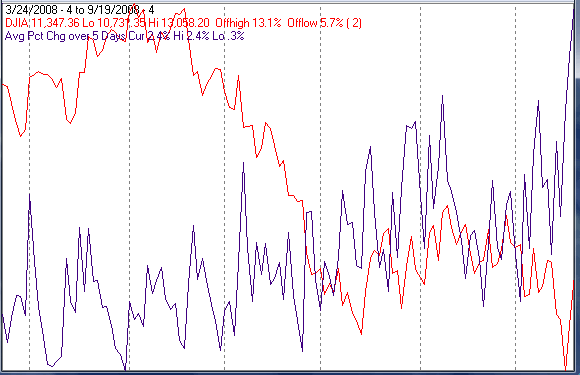
The next chart covers the past 11 years showing the same index and indicator to give you a longer term perspective on its behavior. Dashed vertical lines have been drawn on the 1st trading day of each year.
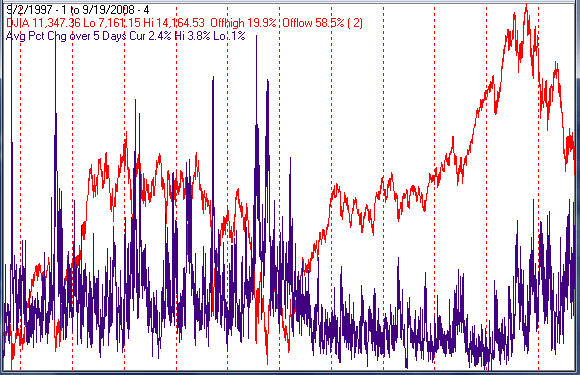
The next chart shows the 2002 low.
The DJIA hit a low in July, rallied 13.4% in 6 trading days, fell 7.6% in 3 trading days then rallied to 17.5% above its July low before resuming its decline into the October low.

As of Friday the DJIA had rallied 5.7% from its low on Wednesday.
Intermediate Term
There were 1304 NYSE new lows on July 15, and all time record number. Last Tuesday there were 1292 NYSE new lows, 12 short of July's record. These extreme numbers imply, at least, one more retest.
The chart below covers the past year showing the DJIA in red and a 10% trend (19 day EMA) of NYSE new lows (NY NL) in blue. NY NL has been plotted on an inverted Y axis so decreasing new lows move the indicator upward (up is good).
New lows declined from 1108 on Thursday to 119 on Friday so NY NL has started moving upward.
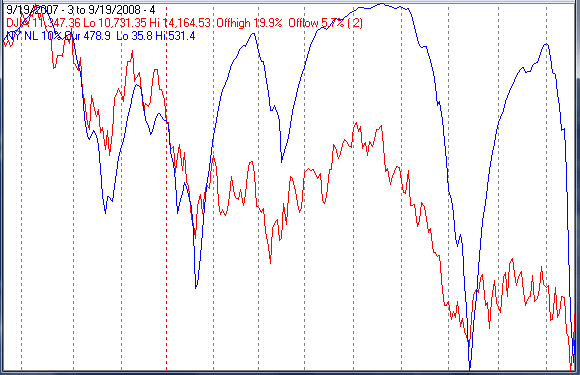
The next chart is similar to the one above except it covers the past 11 years to give you a longer term perspective on that indicator.
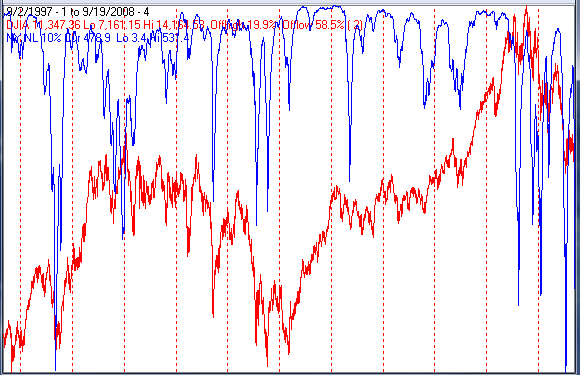
Seasonality
Next week includes the 5 trading days prior to the 4th Friday of September during the 4th year of the Presidential Cycle.
The tables show the daily return on a percentage basis for the 5 trading days prior to the 4th Friday of September during the 4th year of the Presidential Cycle. OTC data covers the period from 1963 - 2007 and SPX data from 1953 - 2007. There are summaries for both the 4th year of the Presidential Cycle and all years combined. Prior to 1953 the market traded 6 days a week so that data has been ignored.
Next week is the one that gives September its bad reputation.
Report for the week before the 4th Friday of September.
The number following the year is the position in the presidential cycle.
Daily returns from Monday through the 4th Friday.
| OTC Presidential Year 4 | ||||||
| Year | Mon | Tue | Wed | Thur | Fri | Totals |
| 1964-4 | 0.28% | 0.52% | 0.33% | 0.21% | 0.56% | 1.90% |
| 1968-4 | 0.03% | 0.14% | 0.00% | -0.09% | -0.08% | 0.00% |
| 1972-4 | -0.05% | -0.15% | 0.07% | -0.16% | 0.13% | -0.16% |
| 1976-4 | 0.31% | 0.58% | 0.02% | -0.18% | 0.04% | 0.76% |
| 1980-4 | 0.31% | -0.45% | 0.07% | -0.58% | -1.69% | -2.34% |
| 1984-4 | -0.74% | -0.31% | 0.09% | 0.02% | -0.14% | -1.09% |
| Avg | -0.03% | -0.04% | 0.06% | -0.20% | -0.35% | -0.57% |
| 1988-4 | -0.12% | 0.17% | 0.21% | -0.01% | 0.03% | 0.28% |
| 1992-4 | -0.09% | -0.95% | -0.01% | 0.51% | -1.49% | -2.03% |
| 1996-4 | -0.67% | 0.31% | 0.77% | 0.27% | 0.17% | 0.86% |
| 2000-4 | -2.83% | 3.73% | 0.82% | -1.76% | -0.66% | -0.69% |
| 2004-4 | -0.11% | 0.69% | -1.85% | 0.04% | -0.37% | -1.60% |
| Avg | -0.77% | 0.79% | -0.01% | -0.19% | -0.46% | -0.64% |
| OTC summary for Presidential Year 4 1964 - 2004 | ||||||
| Avg | -0.34% | 0.39% | 0.05% | -0.16% | -0.32% | -0.37% |
| Win% | 36% | 64% | 80% | 45% | 45% | 45% |
| OTC summary for all years 1963 - 2007 | ||||||
| Avg | -0.22% | 0.00% | 0.13% | -0.36% | -0.20% | -0.65% |
| Win% | 40% | 53% | 60% | 37% | 49% | 44% |
| SPX Presidential Year 4 | ||||||
| Year | Mon | Tue | Wed | Thur | Fri | Totals |
| 1956-4 | -0.39% | -1.40% | 0.15% | -0.48% | -0.55% | -2.66% |
| 1960-4 | -2.27% | 0.28% | 1.04% | -0.38% | -0.85% | -2.18% |
| 1964-4 | 0.46% | 0.04% | 0.02% | 0.11% | 0.25% | 0.87% |
| 1968-4 | 0.57% | 0.34% | 0.00% | -0.22% | -0.05% | 0.64% |
| 1972-4 | -0.18% | -0.06% | 0.05% | -0.16% | 0.08% | -0.27% |
| 1976-4 | 0.05% | 1.42% | -0.34% | -0.50% | -0.11% | 0.51% |
| 1980-4 | 0.89% | -0.74% | 0.73% | -1.27% | -1.84% | -2.23% |
| 1984-4 | -0.24% | 0.21% | 0.40% | 0.41% | -0.52% | 0.26% |
| Avg | 0.22% | 0.23% | 0.21% | -0.35% | -0.49% | -0.22% |
| 1988-4 | -0.68% | 0.34% | 0.16% | -0.36% | 0.22% | -0.33% |
| 1992-4 | -0.19% | -1.18% | 0.07% | 0.25% | -0.98% | -2.04% |
| 1996-4 | -0.08% | -0.13% | 0.03% | 0.01% | 0.05% | -0.12% |
| 2000-4 | -1.45% | 1.07% | -0.59% | -0.16% | -0.02% | -1.15% |
| 2004-4 | -0.56% | 0.63% | -1.39% | -0.47% | 0.16% | -1.63% |
| Avg | -0.59% | 0.14% | -0.34% | -0.15% | -0.12% | -1.05% |
| SPX summary for Presidential Year 4 1956 - 2004 | ||||||
| Avg | -0.31% | 0.06% | 0.03% | -0.25% | -0.32% | -0.80% |
| Win% | 31% | 62% | 75% | 31% | 38% | 31% |
| SPX summary for all years 1953 - 2007 | ||||||
| Avg | -0.40% | 0.03% | 0.02% | -0.21% | -0.20% | -0.75% |
| Win% | 32% | 50% | 56% | 38% | 40% | 38% |
Money supply (M2)
The chart below was provided by Gordon Harms. Money supply growth has fallen below the elevated trend of the past 2 years. With all of the government bailouts, money supply should grow noticeably over the next few weeks.
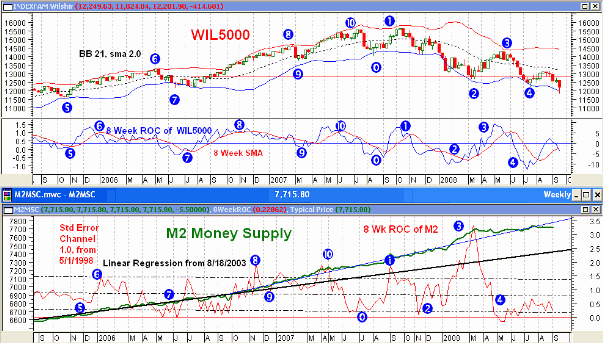
Conclusion
Last weeks retest of the July low was accompanied by enough new lows to make another retest likely. My guess is a rapid growth in money supply will postpone that retest until next year.
I expect the major indices to be higher on Friday September 26 than they were on Friday September 19.
Most of the major indices were up last week, but the DJIA was down so I am calling last weeks negative forecast a tie.
Thank you,
By Mike Burk
To subscribe to this report : http://alphaim.net/signup.html
Gordon Harms produces a Power Point for our local timing group. You can get a copy of that at: http://www.stockmarket-ta.com/ .
Disclaimer: Mike Burk is an employee and principal of Alpha Investment Management (Alpha) a registered investment advisor. Charts and figures presented herein are believed to be reliable but we cannot attest to their accuracy. Recent (last 10-15 yrs.) data has been supplied by CSI (csidata.com), FastTrack (fasttrack.net), Quotes Plus (qp2.com) and the Wall Street Journal (wsj.com). Historical data is from Barron's and ISI price books. The views expressed are provided for information purposes only and should not be construed in any way as investment advice. Furthermore, the opinions expressed may change without notice.
Mike Burk Archive |
© 2005-2022 http://www.MarketOracle.co.uk - The Market Oracle is a FREE Daily Financial Markets Analysis & Forecasting online publication.




